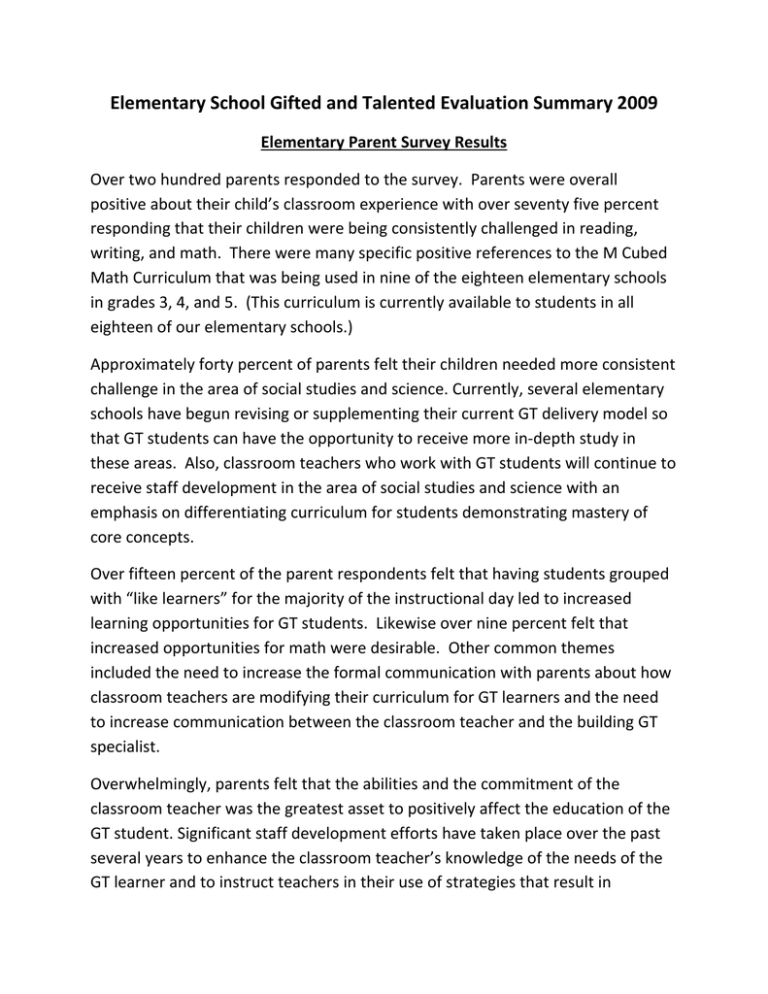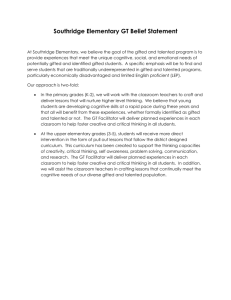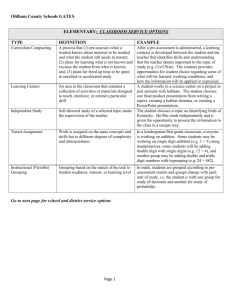Elementary School Gifted and Talented Evaluation Summary 2009
advertisement

Elementary School Gifted and Talented Evaluation Summary 2009 Elementary Parent Survey Results Over two hundred parents responded to the survey. Parents were overall positive about their child’s classroom experience with over seventy five percent responding that their children were being consistently challenged in reading, writing, and math. There were many specific positive references to the M Cubed Math Curriculum that was being used in nine of the eighteen elementary schools in grades 3, 4, and 5. (This curriculum is currently available to students in all eighteen of our elementary schools.) Approximately forty percent of parents felt their children needed more consistent challenge in the area of social studies and science. Currently, several elementary schools have begun revising or supplementing their current GT delivery model so that GT students can have the opportunity to receive more in‐depth study in these areas. Also, classroom teachers who work with GT students will continue to receive staff development in the area of social studies and science with an emphasis on differentiating curriculum for students demonstrating mastery of core concepts. Over fifteen percent of the parent respondents felt that having students grouped with “like learners” for the majority of the instructional day led to increased learning opportunities for GT students. Likewise over nine percent felt that increased opportunities for math were desirable. Other common themes included the need to increase the formal communication with parents about how classroom teachers are modifying their curriculum for GT learners and the need to increase communication between the classroom teacher and the building GT specialist. Overwhelmingly, parents felt that the abilities and the commitment of the classroom teacher was the greatest asset to positively affect the education of the GT student. Significant staff development efforts have taken place over the past several years to enhance the classroom teacher’s knowledge of the needs of the GT learner and to instruct teachers in their use of strategies that result in differentiated experiences for GT students. These efforts will continue in the 2009‐10 school year. Classroom Teachers Survey Results Over one hundred teachers responded to the survey. Sixty‐six percent of the classroom teachers responding said that clustering (groups of 3‐8) GT students in several classrooms of a grade level resulted in an effective way to meet the academic needs of GT students. However, teachers also noted that a wide range of abilities in a classroom can make it difficult for a teacher to spend significant time with one group of students and differentiate curriculum to best meet their needs. Several schools have responded to this issue by clustering GT students in one classroom with the building GT specialist for part of the school day so that it might be easier for instruction to be differentiated. Over eighty percent of classroom teachers said they are able to create and implement differentiated lessons for GT students in reading and math. A balanced literacy approach to language arts instruction and the newer M Cubed math curriculum seem to have helped with differentiation efforts. Ironically, only twenty percent of teachers said they were able to create and implement rigorous lessons in social studies and science. These areas usually take up less of the student day than math and language arts but are extremely important in the overall education of students. Further professional development for classroom teachers, regarding instructional strategies and resources that support differentiation in the areas of social studies and science is needed. Student Survey and Focus Group Results Over six hundred students responded to the survey. Students surveyed responded that teachers were able to challenge them in math more easily than in reading. Sixty‐ three percent said that they always or often saw challenge in math. This may be due in part to the MCubed program referenced earlier. Additionally, the math acceleration policy has impacted GT students as well. Interestingly, forty two percent of students responded that that they are exposed to interesting reading material on a regular basis. Balanced literacy programs that schools currently employ seem to expose students to varied materials. Staff development efforts continue to focus on how teachers can increase the rigor students see in the area of reading, writing, and speaking. Finally, forty four percent of students felt that they had adequate learning time with other GT students. Clustering groups of students in classrooms allows for students to have instructional time together. Two schools piloted instructional models in which the GT specialist delivered the social studies and science curriculum. An additional school is piloting this model during the current school year. Numerous GT students in the focus group stated how much they enjoyed time with their GT specialist and wished that time could be increased. They focused on the strength of the relationship that is developed over time with the GT specialist and how that relationship becomes empowering for the student. Many students also stated that when they had a classroom teacher who “got them” the lack of new and exciting curriculum didn’t seem to matter as much. Being given credit for what they knew or how they learned best seemed to be most important. Classroom teachers will continue to receive staff development regarding the needs of gifted learners. Follow‐ up and Plans for Future Programming During the summer and fall of 2009, elementary GT specialists, the elementary Teacher on Special Assignment (TOSA) for gifted programming, the Gifted and Talented Advisory Council (GTAC) and the Director of Teaching and Learning studied the survey results. Building GT specialists used their building level survey results to help design initiatives and set building goals to address areas of concern identified from the three stakeholder groups. Additionally, buildings with similar goals and initiatives will be able to plan together to provide better programming efforts for GT students. At the district level, the Gifted and Talented Advisory Council, the TOSA for gifted programming and the Director of Teaching and Learning used results in identify district wide trends. These trends, along with additional data, will help shape future programming efforts to best serve the needs of elementary gifted and talented learners. Please contact Pam McDonald, Elementary Teacher on Special Assignment for Gifted Programming at 651‐423‐7945 or at Pam.McDonald@district196.org if you have questions or would like to discuss the results.





